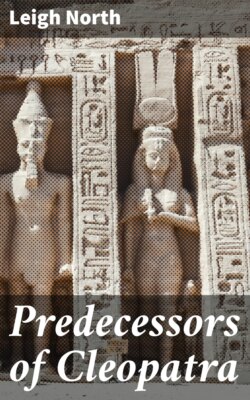Читать книгу Predecessors of Cleopatra - Leigh North - Страница 7
На сайте Литреса книга снята с продажи.
Оглавление“Her form I know; in airless chambers
Of vast old tombs it lives to-day;
The quaint, stiff lines, the rigid posing,
The vivid colors, fresh and gay,
Of raiment striped and barred and fluted,
And tasseled waist and sandaled feet,
That lightly trod, in air and sunshine,
The dust of some Egyptian street.
Her face, I guess at line and color,
Slow almond eyes, with sidelong glance,
And full, calm lips, with curving corners,
Just touched with sleepy scorn perchance,
And straight, low brows, close bound for beauty,
With beaten gold and burning gem,
And the small asp, upreared for striking,
Afront the quaint old diadem.
So richly worn, so darkly splendid,
Looks out her face from shadowland,
Some night methinks I scarce should wonder
To see a living presence stand
Just in the shaft of light thrown dimly
From this old swinging lamp—to hear
A voice that speaks the tongue of Rameses
Fall sweet and strange upon my ear.”
Pen, pencil, brush, and I may add imagination, have depicted for us the royal surroundings. The reigning queen had, like all sovereigns, her tasks to perform. Reports from all parts of the kingdom to receive, the regulation of laws, the commerce and the domestic affairs of her dominions. Luxury surrounded her, attendants and slaves waited upon her bidding. Gold, silver, precious stones and valuable stuffs composed her furniture, her table-service and her attire. Scribes indited at her dictation and royal papyrus bore the impress of her signet, upon which vermilion was rubbed from a small cushion, while blue and a somewhat different stamp was used in religious matters. She dwelt among columns, statues and sphinxes, and, always adorned with flowers and jewels, wore over her shoulders, when in the character of a priestess, the leopard skin of the sacrificer. As special honor to any subject she would bestow upon him a chain of gold and put a ring on his finger. Her throne of ivory was sometimes said to have been so finely carved that a breath would move the foliage represented upon it.
Such in general outline was the position of the Egyptian Queen. But when we approach the individual the difficulties in the study of personality are manifold. Frequently hundreds of years pass and no queen’s name appears—the roll of dynasty after dynasty is searched in vain. In most cases this is enhanced by many names being applied to the same individual, as they are derived from ancient Egyptian, Greek, Persian, or other sources. To this one adds what is called the “Ka” name, a sort of religious addition to the original cognomen.
A parallel to all this might be found in the case of the Duke of Argyle, date 1734, who was also known as John Campbell, MacCallum More, and Ian Roy Cean. The titular, family, and by, or nick-name, signifying “red-headed.” A person searching the archives of Scotland a thousand years hence might be as bewildered in such a case as the Egyptian student is now.
Different authorities give dates hundreds of years apart, different names to the same person, and different spelling to the same name. Some of the queens were taken for men, and only in later and more exhaustive researches was their sex and position ascertained. Nor is this to be wondered at, when the various parts of speech applied to them are of the male gender. Yet here and there a fragment is discovered and we learn something, at least, of many of them.
The partial list extends from the earliest times to the Roman period. Late discoveries give us fragmentary remains from the First Dynasty, but Mertytefs of the Fourth seems the first distinct personality, and the roll, virtually beginning with her, ends with the last and most celebrated Cleopatra. Two of these figures at least stand out with wonderful clearness, the great Hatasu, of the Eighteenth Dynasty, and this same Cleopatra, and while of many others we know much less, we in some cases possess their veritable jewels and ornaments, and in others their actual mummies.
We are working, as it were, to restore a mutilated mosaic. Some of the pieces are altogether gone, many others broken and discolored. From here and there we gather a fragment for our task of restoration. They may vary in shape, they may vary in tint, the recompleted whole is diverse from the original, but it approximates—it gives us an idea of what the perfect design has been, and with that, for the present, we must rest content.
